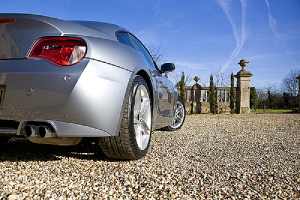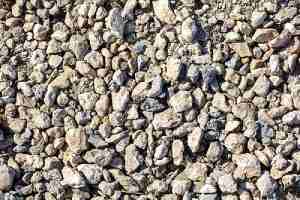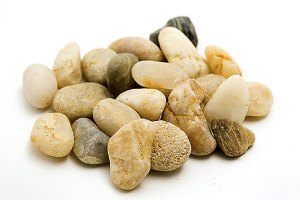 Your driveway is often the first part of your home that your guests will see. The appearance of the driveway contributes greatly to people’s impression of your home, so it is important to have an attractive, well-maintained driveway.
Your driveway is often the first part of your home that your guests will see. The appearance of the driveway contributes greatly to people’s impression of your home, so it is important to have an attractive, well-maintained driveway.
Concrete and asphalt are more popular options for driveways, because they require less maintenance. They are more expensive, though, and will eventually warp and crack, leading to a very unappealing driveway that makes the home look cheap. Gravel requires more maintenance, but it is much more affordable and, if maintained properly, will look nicer and last longer than concrete.
If you have settled on gravel for your driveway material, the next step is to decide which type of gravel to use. This is a confusing topic for many, since people rarely realize that there is more than one type of gravel in the first place. To help you decide, we have listed the best types of gravel for driveways.
Base Gravel #3
Gravel driveways actually consist of three layers of stone, each made with pieces of different sizes. #3 stone is mechanically crushed to a size of one to two inches across. Mechanically crushed stone is vaguely triangular in shape, and this means it will lock together rather than sliding around like round stones will.
Appearance is not an issue here, since this is the base layer and will be covered by other gravel.
#3 stone is an excellent size for creating a stable base that will still allow for proper drainage. A four inch thick layer is the most commonly used thickness.
Item #4
This is another common choice for the foundation of the driveway. This is a mixture of golf ball-sized machine crushed stone along with sand and dirt. It comes in a wide variety of mixtures, some of which include recycled asphalt, or limestone, and various colors, too. All varieties of Item #4 are suitable for the foundation layer of your driveway.
Crushed Stone #57
 Once the foundation is down, you need to apply the middle layer. This typically consists of crushed stone similar in size to golf balls. #57 stone is the most common choice. You will also see this gravel used heavily in landscaping and French drains because it has excellent drainage properties.
Once the foundation is down, you need to apply the middle layer. This typically consists of crushed stone similar in size to golf balls. #57 stone is the most common choice. You will also see this gravel used heavily in landscaping and French drains because it has excellent drainage properties.
It will hold together well without locking together so much as to form an impervious surface. You will rarely find a different gravel used for the middle layer, #57 is really the only choice.
Crushed Stone #411
For the final layer of the driveway, you will typically see a mix of gravel blended with rock dust. #411 is a mix of #57 stone and rock dust. This combination of stone pieces and dust will fit tightly together, the dust sealing the spaces between the stones, to form a stable load-bearing surface for your driveway.
This gravel will create a smooth appearance and will hold together on its own fairly well, for a relatively low-maintenance driveway.
Quarry process
You may also see this called crusher run. Like #411, this is a blend of small crushed stones and rock dust. The difference is that the stones are smaller and there is a high percentage of rock dust in the mixture. The extra dust will form a smooth, solid surface as the gravel settles. This adds a lot of durability to the driveway, but it will need to be crowned.
Crowning means grading the driveway so that the center is higher than the sides. With quarry process, this is necessary to ensure that rain water drains properly.
Quarry process driveways looks almost like paved driveways until you get close. The strong, smooth surface they form will last a long time, which makes them an excellent choice.
Pea Gravel
 Pea gravel is the most visually attractive option. It consists of small, weathered stones that are naturally smooth and round. It is often multicolored, too. In fact, pea gravel is probably what many individuals picture when they hear the word “gravel.”
Pea gravel is the most visually attractive option. It consists of small, weathered stones that are naturally smooth and round. It is often multicolored, too. In fact, pea gravel is probably what many individuals picture when they hear the word “gravel.”
Because it looks nice, pea gravel is a very popular choice for the top layer. The only problem is that the smooth, rounded stones will not lock together in the same way that crushed stones and rock dust will. Pea gravel driveways will require much more maintenance and may need some solid edging to hold the top layer in place.
Even with the edging material, you may need to rake the gravel a time or two each year. Raking helps keep the loose gravel in one spot, in addition to smoothing out the surface and making it look nice.
Jersey Shore Gravel
This is a gravel consisting of small, rounded stones that are yellow, golden, or tan in color. The coloration makes it look like beach sand, and it is a popular gravel choice on the East Coast, hence the name.
Essentially, this is pea gravel of a specific color scheme. That means that, while it will look very good, it will require all of the extra maintenance that pea gravel needs. Regular raking of the gravel and edging material to hold it all in place will both be needed.
Marble Chips
White marble can be breathtaking in the sunlight. It sparkles and shines, and creates a truly elegant driveway. Of course, that all comes with a cost: white marble is much more expensive than other gravels, and the cost is prohibitive for many.
In addition to the cost, marble chips, like pea gravel, are smooth. You will need edging material to hold it in place, or your expensive stone will all wash away. It may be worth it though, as marble really does look quite good.
No matter which gravels you choose, you will need professional assistance in creating your driveway. At Dirt Connections, we can help with that. If you have any questions about these gravel types that have not been answered here, or if you would like help in sourcing gravel for your driveway, give us a call. We are here to help.










































